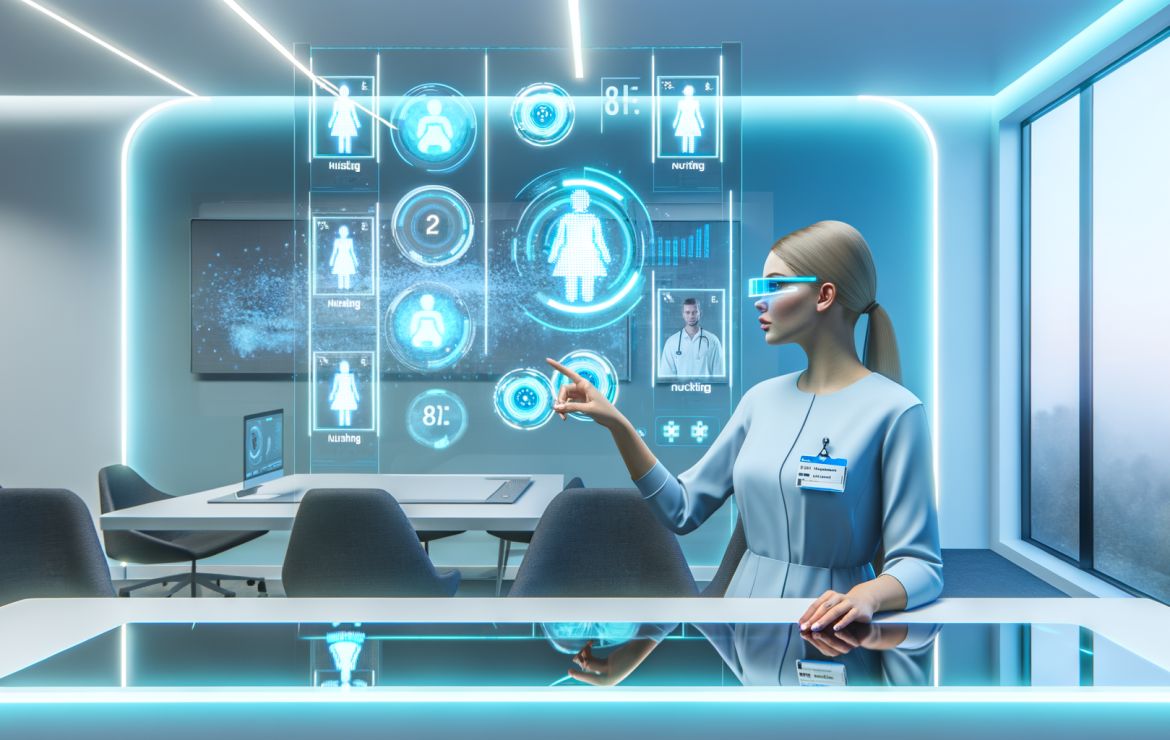How AI and VR Are Revolutionizing Nurse Recruitment in 2025

Emerging Technologies Transforming Nursing Recruitment: Addressing Workforce Shortages and Enhancing Hiring Efficiency
In the face of an unprecedented nursing shortage crisis, the healthcare industry is turning to cutting-edge technologies to revolutionize recruitment practices. As the demand for skilled nursing professionals continues to outpace supply, innovative solutions are emerging to streamline hiring processes, enhance candidate assessment, and accelerate onboarding. This article explores how artificial intelligence (AI), virtual reality (VR), and advanced analytics are reshaping nursing recruitment, offering hope in addressing workforce shortages and improving hiring efficiency.
The Nursing Shortage: A Growing Crisis
The nursing profession is facing a critical juncture. The American Nurses Association (ANA) has sounded the alarm, predicting a shortage of over 78,000 full-time registered nurses (RNs) by 2025. This shortfall is not a temporary blip but part of a long-term trend. The Bureau of Labor Statistics projects a 6% growth in registered nurse positions before 2033, highlighting the urgent need for innovative recruitment strategies.
The reasons behind this shortage are multifaceted:
- An aging nursing workforce with many approaching retirement
- Increasing healthcare demands from an aging population
- Limited capacity in nursing schools to train new professionals
- High burnout rates leading to early career exits
As healthcare institutions grapple with these challenges, they are increasingly turning to technology to bridge the gap between supply and demand in the nursing workforce.
Key Emerging Technologies in Nursing Recruitment
Artificial Intelligence (AI)
AI is revolutionizing the recruitment process by automating and enhancing various aspects of candidate selection and evaluation. Here’s how AI is making a difference:
1. Resume Screening and Candidate Profiling
AI-powered algorithms can quickly analyze thousands of resumes, identifying key qualifications, experience, and skills that match job requirements. This not only saves time but also reduces human bias in the initial screening process.
Julie Stegman, Vice President of the Health Learning & Practice Segment, notes, “AI is transforming how we identify and assess potential nursing candidates. By analyzing patterns in successful hires, AI can predict which applicants are most likely to excel in specific roles.”
2. Tailored Interview Question Generation
AI systems can generate personalized interview questions based on a candidate’s resume and the specific requirements of the nursing position. This ensures that interviews are more focused and effective in assessing a candidate’s suitability.
3. Personalized Learning Paths
Once hired, AI can create individualized learning paths for new nurses, adapting to their strengths and areas for improvement. “The fusion of Artificial Intelligence and Virtual Reality will transform how new-to-practice nurses develop essential skills,” says Stegman, highlighting the potential for accelerated skill development.
Virtual Reality (VR)
Virtual Reality is creating immersive experiences that enhance both the recruitment and onboarding processes:
1. Immersive Learning Environments for Training
VR simulations allow nursing candidates and new hires to practice complex procedures and decision-making in a risk-free environment. This technology can simulate high-stress scenarios, rare conditions, and intricate medical procedures, providing invaluable hands-on experience without patient risk.
2. Enhanced Onboarding Experiences
VR is revolutionizing the onboarding process for new nurses. A recent case study on onboarding new nurse educators using VR demonstrated significant improvements in readiness for real-world practice. The study found that VR-based onboarding reduced the time to proficiency by 40% compared to traditional methods.
Dr. Sarah Johnson, Director of Nursing Education at a leading hospital, shares, “Our VR onboarding program has been a game-changer. New nurses feel more confident and prepared, which translates to better patient care from day one.”
Advanced Data Analytics
The power of data is being harnessed to transform nursing recruitment and workforce management:
1. Predictive Staffing Needs
Advanced analytics can forecast staffing requirements based on historical data, seasonal trends, and other relevant factors. This allows healthcare institutions to proactively address potential shortages and optimize their recruitment efforts.
2. Trend Forecasting and Data-Driven Decision Making
By analyzing vast amounts of data, healthcare organizations can identify trends in nurse turnover, satisfaction, and performance. This information informs strategic decisions in recruitment, retention, and professional development.
3. Impact on Addressing Nursing Shortages
Data analytics helps identify the root causes of nursing shortages in specific regions or specialties. This insight enables targeted recruitment campaigns and the development of tailored retention strategies.
The Impact of Emerging Technologies on Nursing Recruitment
The integration of AI, VR, and advanced analytics is yielding significant benefits in nursing recruitment:
Improved Efficiency in Hiring Processes
The use of AI for resume screening and initial candidate assessment has dramatically reduced the time-to-hire. Many healthcare institutions report a 30-50% reduction in recruitment cycle times after implementing AI-driven processes.
Enhanced Candidate Assessment and Selection
VR simulations and AI-powered assessments provide a more comprehensive evaluation of a candidate’s skills and potential. This leads to better-matched hires and reduced turnover rates.
Accelerated Onboarding and Training
VR-based training programs and personalized learning paths powered by AI are shortening the time it takes for new nurses to become fully productive. Some institutions report a 25% reduction in the time required for new nurses to reach full competency.
Better Alignment of Staffing with Healthcare Demands
Advanced analytics enable healthcare organizations to anticipate staffing needs with greater accuracy. This proactive approach helps maintain optimal nurse-to-patient ratios, improving both patient care and nurse job satisfaction.
Challenges and Considerations
While the benefits of these technologies are clear, their implementation is not without challenges:
Resistance to New Technologies in Healthcare Environments
Dr. Lori Wightman, senior director of professional practice at the American Organization for Nursing Leadership, observes, “Nurses are not afraid of technology. However, there are historical practices and concerns within healthcare work environments that increase resistance.”
To overcome this resistance, Dr. Wightman recommends:
- Involving nurses in the selection and implementation of new technologies
- Providing comprehensive training and support
- Demonstrating clear benefits to patient care and nurse workflow
Work-Life Balance and Burnout Concerns
As technology streamlines recruitment and onboarding, it’s crucial not to lose sight of the human aspect of nursing. Gen Z nurses, in particular, place high value on work-life balance and meaningful work.
Gail Vozzella, chief nurse executive at Houston Methodist, emphasizes, “Health systems must be ready to offer new nurses enticing hiring packages with benefits, and check in with them throughout their first year of employment.”
Strategies to address these concerns include:
- Implementing flexible staffing models
- Offering robust mental health and wellness programs
- Creating clear career development paths
- Fostering a culture of support and recognition
Future Outlook and Trends
The future of nursing recruitment is poised for further technological advancements:
Integration of AI and VR in Nursing Education
Nursing schools are increasingly incorporating AI and VR into their curricula, preparing students for the technology-rich environments they’ll encounter in their careers.
Remote Work and Telehealth Implications for Recruitment
The rise of telehealth is creating new opportunities for nurses to work remotely, expanding the potential talent pool for healthcare organizations.
Blockchain Technology for Credential Verification
Blockchain is emerging as a secure and efficient method for verifying nursing credentials, streamlining the hiring process and reducing fraud.
Personalized Career Development Paths Using AI
AI-driven platforms will offer nurses personalized career guidance, suggesting training opportunities and career paths based on their skills, interests, and market demand.
Ethical Considerations
As healthcare organizations embrace these technologies, several ethical considerations must be addressed:
Ensuring Patient Safety with New Technologies
While technologies like VR can enhance training, it’s crucial to ensure that they do not replace essential hands-on experience with real patients.
Addressing Potential Biases in AI Recruitment Algorithms
AI systems must be regularly audited and refined to prevent perpetuating biases in hiring decisions.
Data Privacy Concerns in Advanced Analytics
Healthcare organizations must implement robust data protection measures to safeguard both patient and employee information used in recruitment analytics.
How To: Implementing AI in Nursing Recruitment
For healthcare organizations looking to leverage AI in their recruitment processes, here’s a step-by-step guide:
1. Assess Current Recruitment Challenges and AI Potential
- Identify bottlenecks in your current recruitment process
- Determine which areas could benefit most from AI integration
2. Select Appropriate AI Tools for Specific Needs
- Research AI platforms specializing in healthcare recruitment
- Consider factors such as integration capabilities, customization options, and scalability
3. Develop a Pilot Program for AI Integration
- Start with a small-scale implementation in one department or for specific roles
- Set clear metrics to measure the impact of AI on recruitment efficiency and quality
4. Train Recruitment Staff on AI Tool Usage
- Provide comprehensive training on how to use and interpret AI-generated insights
- Address concerns and emphasize the role of human judgment in decision-making
5. Establish Feedback Mechanisms for Continuous Improvement
- Regularly gather feedback from recruiters, hiring managers, and candidates
- Use this feedback to refine AI algorithms and processes
FAQ Section
Q1: How can healthcare institutions attract and retain Gen Z nurses?
A1: To attract and retain Gen Z nurses, healthcare institutions should focus on:
- Promoting social justice initiatives within the organization
- Offering flexible work arrangements to support work-life balance
- Providing clear career progression paths and mentorship programs
- Emphasizing the meaningful impact of nursing roles
- Implementing state-of-the-art technology in nursing practice
Q2: What are the potential drawbacks of using AI in nursing recruitment?
A2: While AI offers many benefits, potential drawbacks include:
- Risk of algorithmic bias if not properly designed and monitored
- Over-reliance on technology, potentially overlooking nuanced human qualities
- Initial implementation costs and learning curve for staff
- Potential loss of the personal touch in recruitment processes
- Data privacy concerns if not managed correctly
Q3: How can VR training complement traditional nursing education?
A3: VR training complements traditional nursing education by:
- Simulating high-stress scenarios in a safe environment
- Allowing practice of rare conditions and complex procedures
- Providing immediate feedback and performance metrics
- Enabling repetitive practice without patient risk
- Offering standardized training experiences across different locations
Q4: What role does data privacy play in advanced analytics for nursing recruitment?
A4: Data privacy is crucial in advanced analytics for nursing recruitment:
- Ensure compliance with HIPAA and other relevant regulations
- Implement robust data protection measures, including encryption and access controls
- Obtain informed consent for data usage in recruitment processes
- Regularly audit data handling practices and update as necessary
- Train staff on data privacy best practices and potential risks
Q5: How can smaller healthcare facilities benefit from emerging recruitment technologies?
A5: Smaller healthcare facilities can benefit from emerging recruitment technologies by:
- Leveraging cloud-based AI solutions that don’t require significant infrastructure investment
- Participating in shared VR training programs with other facilities
- Utilizing data analytics for targeted, cost-effective recruitment strategies
- Implementing modular technology solutions that can scale with the facility’s growth
- Focusing on technologies that offer the highest ROI for their specific recruitment challenges
Success Story: AI-Driven Recruitment at Major Hospital Network
Mercy Health System, a large hospital network in the Midwest, implemented an AI-driven recruitment system in 2024 to address their nursing shortage. The results after one year were impressive:
- Time-to-hire reduced by 30%, from an average of 45 days to 31 days
- Candidate quality improved, with a 25% increase in successful hires passing their 90-day probation
- Job satisfaction rates among new hires increased by 15%
- Cost savings of $500,000 in recruitment process efficiencies
Sarah Thompson, Chief Nursing Officer at Mercy Health, shares, “The AI system has transformed our recruitment process. We’re not just filling positions faster; we’re finding better matches for our culture and needs. This has led to improved retention and job satisfaction across the board.”
Conclusion
The integration of AI, VR, and advanced analytics in nursing recruitment represents a paradigm shift in how healthcare organizations address workforce shortages and enhance hiring efficiency. These technologies offer promising solutions to longstanding challenges in the nursing profession, from streamlining the hiring process to improving the quality of candidate selection and accelerating onboarding.
As we look to the future, it’s clear that the successful implementation of these technologies will require a balanced approach. Healthcare organizations must embrace innovation while also addressing the human elements of nursing recruitment and retention. By leveraging these emerging technologies thoughtfully and ethically, the healthcare industry can work towards resolving the nursing shortage crisis and ensuring high-quality patient care for years to come.
The call to action for healthcare institutions is clear: embrace technological innovation in recruitment processes, but do so with a keen eye on ethical considerations, data privacy, and the unique values of the emerging nursing workforce. By doing so, they can not only address current shortages but also build a more resilient and satisfied nursing workforce for the future.









